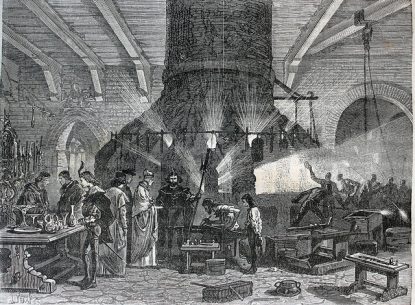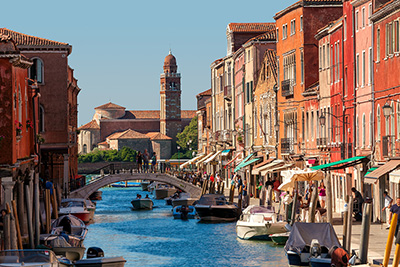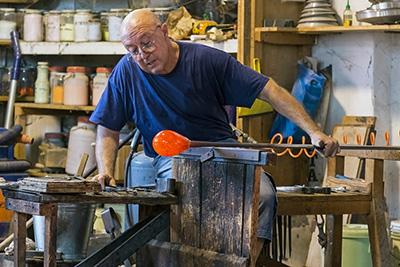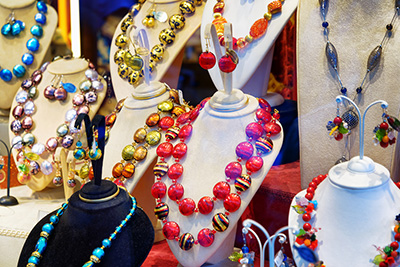
Venetian art glass has been incredibly popular since around the 8th century. Made in Venice, Italy, almost exclusively on the island known as Murano, Venetian glass is unmistakable due to its colourful, bold, and elaborate designs.
During the Middle Ages, the Venetian Republic was one of the wealthiest and most powerful republics in all of Europe. This was mainly because Venetian glass was such a valuable commodity at the time.
To this day, in many Venetian glassmaking families, Murano glassmaking recipe books dating back generations are passed down from father to son.
Murano Glass Originated in Venice

Originally, during the 8th century AD, the city of Venice became one of the most prominent glass manufacturing hubs on the face of the Earth. Not long after, in the year 1291, Venetian art glass production was forced to relocate from Venice to Murano Island, which is situated within the Venetian Lagoon. Ancient Roman glass-making techniques, long thought to have been lost forever, were re-learned by glassmaking masters of Murano, and Murano glass became more popular than ever.
Murano Glassmakers Utilised Minerals for Colour
Murano glass is instantly recognisable, as it has some of the most stunning and vivid colours you’re ever likely to see. Ancient Murano glass masters traditionally made use of mineral oxides and minerals to create the vivid glass colours. These minerals were added to the glass mixtures and created truly amazing finishes and textures. For blues, Azurite and Cobalt were used. For green glass ornaments, iron was used; for pink and violet, manganese was used; and for red, gold was used.
Murano Glassmakers Were Treated Like Royalty

So popular was Murano glass that the ancient Murano glassmaking masters were actually granted immunity from prosecution, and could legally wear swords during the 14th century. Their daughters would also often marry into some of the most affluent and powerful families in all of Venice.
Murano Glassmakers Could Not Leave Murano
Whilst there were some considerable perks associated with being a Murano glassmaker, there were also some drawbacks to contend with. To safeguard the unique Venetian art glass manufacturing and blowing techniques, Murano glassmakers were not legally allowed to leave the Republic of Venice. As they were immune from prosecution, the punishment for disobeying these laws was death. Some, however, took the risk and left to set up glassmaking foundries in other parts of the country and the world.
Just Under 50% of Murano’s Inhabitants Worked in the Glassmaking Industry in Some Capacity
During the 16th century, Murano had a population of around seven thousand. Of these people, just over three thousand were involved in Murano glassmaking in some capacity. The island of Murano relied almost exclusively on Murano glass for its economy.
Murano Began Trading with the Rest of the World during the 17th Century

During the 17th century, a number of new sea routes came into operation, linking Italy with other countries. Seeing room for expansion, not only were Murano glass ornaments produced on a massive scale, but a number of other products came into existence. In particular, Murano glassmakers began creating stunning glass mirrors, which proved to be hugely lucrative creations for the island.
Chinese Glass Almost Destroyed Venetian Art Glass
For centuries upon centuries, Murano had been the primary hub for worldwide glassmaking. This all changed between the 17th and 19th centuries, thanks to China. Many glassmaking furnaces were closed down as China, thanks to the new sea routes, stepped in and created cheaper Chinese glass. As time went by, the technique of Murano glass-blowing became almost a lost art. However, in 1866, a man named Antonio Salviati created a brand new Murano glassmaking foundry. Known as Salviati e Co, the foundry traded with virtually all of Europe, and the products were exceptional. Because of the popularity of the products, Murano Glass was back in business, and once again, more foundries began opening for trade.
Murano Beads Were Used as Currency
In 1480, one of the most famous Venetian art glass Murano beads of all time was created. This bead was known as the Rosetta bead and was prepared using a star-shaped mould and a cane. The Rosetta bead was incredibly popular and was used as a form of trade currency.
